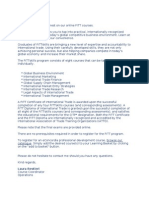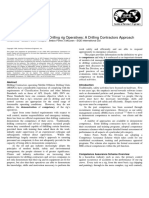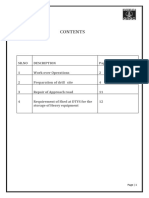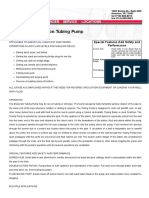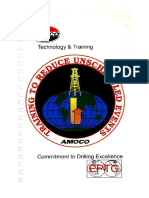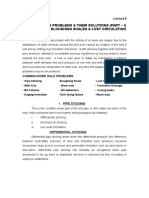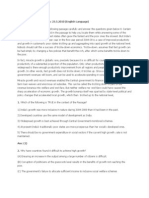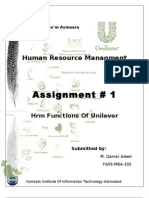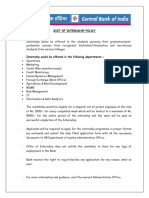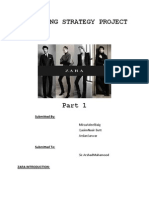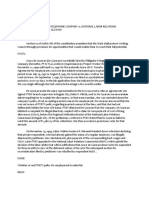IADC/SPE 87102 Specialized Rig-Crew Training Produces Results For New Technology Drilling Rigs
IADC/SPE 87102 Specialized Rig-Crew Training Produces Results For New Technology Drilling Rigs
Uploaded by
msmsoftCopyright:
Available Formats
IADC/SPE 87102 Specialized Rig-Crew Training Produces Results For New Technology Drilling Rigs
IADC/SPE 87102 Specialized Rig-Crew Training Produces Results For New Technology Drilling Rigs
Uploaded by
msmsoftOriginal Title
Copyright
Available Formats
Share this document
Did you find this document useful?
Is this content inappropriate?
Copyright:
Available Formats
IADC/SPE 87102 Specialized Rig-Crew Training Produces Results For New Technology Drilling Rigs
IADC/SPE 87102 Specialized Rig-Crew Training Produces Results For New Technology Drilling Rigs
Uploaded by
msmsoftCopyright:
Available Formats
IADC/SPE 87102 Specialized Rig-Crew Training Produces Results for New Technology Drilling Rigs
Richard A. Plageman, Helmerich & Payne International Drilling Co., Scott A. Milliren Helmerich & Payne International Drilling Co., J.D. Blackman, Helmerich & Payne International Drilling Co.
Copyright 2004, IADC/SPE Drilling Conference This paper was prepared for presentation at the IADC/SPE Drilling Conference held in Dallas, Texas, U.S.A., 24 March 2004. This paper was selected for presentation by an IADC/SPE Program Committee following review of information contained in a proposal submitted by the author(s). Contents of the paper, as presented, have not been reviewed by the International Association of Drilling Contractors or Society of Petroleum Engineers and are subject to correction by the author(s). The material, as presented, does not necessarily reflect any position of the International Association of Drilling Contractors or Society of Petroleum Engineers, their officers, or members. Papers presented at IADC/SPE meetings are subject to publication review by Editorial Committees of the International Association of Drilling Contractors and Society of Petroleum Engineers. Electronic reproduction, distribution, or storage of any part of this paper for commercial purposes without the written consent of the International Association of Drilling Contractors and Society of Petroleum Engineers is prohibited. Permission to reproduce in print is restricted to a proposal of not more than 300 words; illustrations may not be copied. The proposal must contain conspicuous acknowledgment of where and by whom the paper was presented. Write Librarian, SPE, P.O. Box 833836, Richardson, TX 75083-3836, U.S.A., fax 01-972-952-9435.
Abstract This paper describes a successful training program that bridged the gap between machine capabilities and human skills. The program was conducted in support of a landdrilling rig construction project utilizing leading edge technology in rig components and manufacturing techniques. The targeted training was designed to accelerate the learning curve and provide the rig crews a foundation of skills and knowledge that allowed them to excel beyond the company and industry expectations. The curriculum was developed in part from organizational learnings taken from previous newbuild programs and from equipment manufacturers recommendations and expertise. The combined effect of focused training, organizational learning, and leading edge technology has lead to superior performance in the field. To date, the Total Recordable Incident Rate (TRIR) is 76% lower than comparable, in-house, new-build programs. Likewise, turnover is 70% lower than the past projects. Out of 169 wells drilled by these new rigs, 70% of all wells are below and 6% are on target with the customers estimated drilling time. Introduction A drilling company embarked on a major new-rig build program that consisted of thirty-two highly advanced, land drilling rigs. These FlexRigsTM incorporated leading edge technology never utilized on land drilling rigs. Because the company built such a large number of units, lean manufacturing techniques were employed to take advantage of the economy of scale and produce the rigs more cost effectively. Traditionally, the rig crews are hired before the rig is built and they provide the bulk of construction labor. Through
on-the-job (OJT) experience gained during rig construction, the crews acquire an intimate knowledge of their rig. As part of the overall construction plan, the rig crewmen were not hired until the rig was complete, resulting in men who knew very little of their rig before they were tasked to drill for a customer. This lack of skills plus the new equipment associated with the technology and the volume of rigs being built caused concern in the companys leadership as to whether there would be enough skilled crewmen to safely and effectively operate all these rigs. Therefore, the company decided to invest in a training program to ensure that the people who operate these rigs will have the necessary skills to excel from start-up. The size of this program was very large in terms of financial investment, number of attendees and briskness of pace. Seven hundred people would eventually attend the training. The company invested $2.5 million in the training program and made available another $2.5 million in assets for hands-on exercises of critical procedures. Rig crews were trained in eight-day cycles that occurred every two weeks for the first twenty-five rigs. Quality training programs follow a process that begins with a needs assessment. Once the upfront analysis is complete, the next step is to develop the program and then deliver the instruction. The final part of a training program is to evaluate the effectiveness of the instruction. Needs Assessment The goal of a needs assessment is to identify the desired performance, the current status of performance and then, if valid, to pinpoint the training needs. According to Robert Majer1, this is a three-step process: 1) Analyze goals, 2) Analyze performance, and 3) Analyze tasks. Project Goals. The company leadership set high expectations for the overall project in order to improve value for the companys customers. The first goal was to reduce safety and environmental incidents. This was to be achieved by using safety by design techniques and developing new ideas to eliminate known hazards. The second goal was to improve productivity in reducing the customers total well cost and well cycle time. To meet this goal, one important factor the company focused on was to maximize crew retention by making the rig crewmens jobs more attractive. By reducing the likelihood of injury, reducing the amount of drudgery, and giving the crews exposure to cutting-edge technology, the company believed
www.petroman.ir
SPE/IADC 87102
that people would be more likely to stay employed long-term. This will result in better crew integrity and ultimately improve productivity. Another way the company wanted to improve productivity was to capture and use organizational learnings. The construction team established regular forums with field leadership so that best practices would be integrated into the new rig design. Other means for implementing lessons learned came from the HSE management system, the Rig Asset Management System (RAMSTM), other training programs and the use of the companys Wide Area Network to share organizational learnings. The company took this wealth of knowledge and used it to apply new ideas in design and technology. The last goal was to build the right rig at the best value. To accomplish this, the company implemented Lean Manufacturing techniques to take advantage of the economy of scale in building thirty-two identical rigs. This meant that rig crews would not be part of the construction effort and would meet their rig for the first time during mobilization to the first well site. Performance Analysis. Majer1 describes a performance analysis as a tool to use to find out the differences between what people should be doing and what they are doing. Then a decision can be made as to whether instruction or some other action is needed to correct the problems. An analysis of a previous new rig build program uncovered situations where training would have helped. Some examples include damage to equipment and excess downtime because the crews did not know proper operating procedures; excess drilling times because drillers did not understand the optimum techniques in operating the advanced rig control systems, and higher than expected turnover due to frustration with the rig and new team members. All three of these examples could have been prevented if the teams knew how to operate and care for the equipment and if they had been given the opportunity to build a team foundation before going to the rig site. In the new project, the potential for similar events was very high. The volume of rigs, volume of people and the extent of new technology created a high risk that the rig teams would not be able to meet the project goals. Relying on OJT would not create successful start-ups and could ultimately cost the company millions of dollars in lost revenue, maintenance repairs and a battered reputation. Therefore the company leadership decided that a formal training program was needed. Task Analysis. The last step in the needs analysis is to pinpoint what should be taught. Majer points out that the task analysis will reveal the components of competent performance in a step-by-step look at how competent people perform a task2. It is beyond the scope of this paper to describe the elements of the all the tasks in the analysis. However, it is appropriate to discuss the categories of tasks in terms of skill sets useful to the rig crews in order to meet the project goals. The first project goal was to reduce safety and environmental incidents. To accomplish this the newly formed rig teams had to follow the companys established
safety processes. Major tasks included performing STOP observations, writing Job Safety Analyses, performing and/or participating in a Lock Out/Tag Out process, performing a Dropped Object Inspection, attaching lacing wire to bolt heads, and hoisting personnel. The second project goal was to reduce the total well cost and cycle time. This is accomplished by ensuring the rig equipment is available to operate when needed and the crews know how to use it. Operation and maintenance skills of the following systems would be critical in meeting the second goal: Varco Automated Drawworks System (ADS-20SD), Varco Integrated Control and Information System with Electronic Driller (VICIS-eD), the Variable Frequency Drives (VFD) and AC motors, Varco TDS-11HP, power generation system, hydraulics system, air system, solids control system, and the Varco ST-80 mechanized tongs. The last skill set also supports the second project goal. The rig crews were created out of a pool of existing employees and newly hired personnel. The teams were assembled for each rig and needed to go through the forming and storming phases of the Team Growth3 cycle in order to set themselves up for optimum performance at the rig site. The key skills included effective communication, trust, planning, and shared leadership. Program Development Once the projects goals were understood, the need for training was established and the skills to teach were identified, the next step was to develop the program. Just like it did in rig design, the company decided to leverage organizational learnings to create the training program. Training was a main topic at the regular forums held with field leadership. Curriculum, costs and logistics were all discussed and agreed upon by several layers of management. This approach fostered an atmosphere of open communication, which led to strong leadership support. Target Population Analysis. Before the details of how to implement the training program are fully developed, trainers must analyze the characteristics of the attendees. There are six categories of information that will paint an accurate picture of who will be trained: Interests, Prior Training, Personal Benefit to Learning, Attitudes and Biases, Physical Characteristics and Cultural Characteristics4. By describing the audience in these terms, the curriculum can be tailored with examples, methods and amount of material to best fit the audience and increase the amount of retention. The people who were to attend the rig training have specific characteristics as listed below. 1. Interests: Rig crewmen are generally outdoorstype people. Some of their hobbies include hunting and fishing. Many of these people work on cars and build homes. Quiet time is not a top priority. 2. Prior Training: Most of these people will have attended safety training tailored to rig work and some will have had formal training on drilling processes. Many will also have experience with earlier versions of the equipment. 3. Personal Benefit to Learning: Most of the people will see the training as necessary to be able to effectively
www.petroman.ir
SPE/IADC 87102
operate the new rigs. Some will perceive the training as a negative consequence for being put on the new rig. 4. Attitudes and Biases: Because of the high technology and fear of not being able to work the equipment properly, many of the learners will be open to learning the new skills. Some will attend because they have to and will not be fully engaged. The learners will not have a strong bias to classroom style lecture and must have activity to keep them engaged. 5. Physical Characteristics: Almost the entire class will be male. The job-roles they fill are physical in nature. 6. Cultural Characteristics: There will be a combination of English and Spanish speaking individuals. The majority of people will be able to speak and read English. There will be a mix of newly hired personnel and employees with company experience. There are several key results from this analysis. First, the attendees will respond best to hands-on activities that will allow them time to practice the skills. Second, the training must not be a repeat of past experiences; but, must address the company-culture issues associated with newly hired employees. All the topics covered should build off the learners current skills with equipment and HSE. Third, the physical characteristics of the class dictate that long lectures will not be received well. To provide variety, the program should use a combination of lectures, small group activities, and hands-on practice. Vision and Scope. With the analyses complete, the training team set the vision and scope for the program. The FlexRig3TM training program was designed to provide a practical, start-up training program that: 1. Teaches hands-on rig skills. 2. Is a quality, professional and organized training effort. 3. Is adaptable to changes in operational needs. 4. Is relevant. 5. Is supported by leadership. 6. Helps eliminate recurring problems through organizational learning. This program utilized actual rigs in the fabrication mode as well as rig components displayed in a dedicated training facility. The instructors came from within the companys operations and included the rig-level leadership. The training curriculum focused on HSE instruction combined with technical and operational topics. This foundation was then enhanced by the introduction of people skills. The goal in mind was to provide the crews with the tools required to work successfully as a team. Curriculum. We designed the curriculum to meet the basic skill needs of the rig crewmen as defined in the task analysis. Table 1 is a matrix of course titles. The courses are grouped by the three broad areas of HSE, technical and people skills and pinpoint the requirements for each position. The training team enlisted help from many sources within and outside the company. The HSE classes were created using the material from the companys land, offshore and international operations. HSE professionals and field leaders alike contributed their lessons learned and teaching tools. The
company enlisted the help of a third party training vendor that specializes in experiential learning to design and deliver the teambuilding classes. The company, in concert with the original equipment manufacturers (OEMs), designed the equipment operation and maintenance classes. The OEMs provided invaluable assistance in creating the equipment related courses. Their involvement ranged from consulting on course design to full course construction and teaching. Alberto Ramirez and Dharmesh Prasad state that Trainees are motivated to (learn new skills) when (1) they are confident about using the skills, (2) perceive job-performance improvement will likely occur as a result of use of the new skills, and (3) believe that the knowledge and skills emphasized will help solve work-related problems.5 Therefore the classes were created from the perspective of the learner and the course objectives bear that out. Those learning objectives are detailed in Appendix 1. To further establish the link between training and work, each course was designed with as much hands-on instruction as possible. Actual rig components were staged in the training center to allow unfettered access during class. Major pieces of equipment included an ADS, an TDS-11HP with pipe handler and traveling block, an VFD house, an Engine/Generator set, dual air compressors and solids control equipment. These pieces were extremely useful in the practical experience of operation and care of the equipment. For the hands-on safety skills training, the company built a fully functioning personnel hoisting skid, rigged up floor tools, and created a mock-up of the rigs lock out/tag out system. Program Delivery The FlexRigTM3 training program was conducted in a dedicated facility in a Greens Port, Houston warehouse that was located near the rig assembly facility. All pieces of equipment were rigged up, permanently, until fabrication on the last rig. Then the rig components were put into service. The rig crews attended between ten and four days of training based on their position (refer to Table 1). Rig Managers, Tourpushers, Drillers and Assistant Drillers attended ten days of training. Derrickmen and Motormen attended eight days and Floormen attended four days. Since Floormen account for over 65% of all company turnovers, the purpose of the tiered training system was to maintain a costeffective program. The logical course of action was to teach the experienced, long-term employees who then would teach and coach the new employees on the proper skills. If the new Floormen were to leave the company, the lost investment is not as great as if they attended all eight days. The first twenty-five rigs were to be built at a pace of one complete rig every fourteen days. This meant that two complete rig crews had to be trained every month. The crews began their training cycle as close to the rigs mobilization as possible. Daily class consisted of a combination of lecture, small group instruction, and hands-on practice with the equipment. The first two days for the Rig Managers and Drillers were conducted off-site at an OEM facility in Cedar Park, TX. The Derrickmen and Motormen joined the rig leadership in Houston for the next four days, which were dedicated to the maintenance and operation of the rig equipment. Day five in Houston was a teambuilding day and
www.petroman.ir
SPE/IADC 87102
marked the first day that the full crews worked together. The teambuilding event used experiential learning techniques to help the rig teams develop the people skills necessary to get through the forming and storming phases. The last three days were dedicated to HSE skills training and maintenance tasks. In the last three days the instructors coached the rig leadership to help set the standards of conduct for the team. Unique to this training event was the crews access to the full drilling rig. At the end of each training day, the crews went to the rig-up yard for more hands-on learning. The Rig Managers were given a copy of the rig procedures at the beginning of the program and some expectations on what tasks they should focus their crews attention at the rig-up yard. Examples include rig-up procedures, string-up procedures, BOP handling procedures, bringing generators online and working with the VICIS-eD system. The Rig Managers directed the learning process in the yard and each morning the instructors facilitated a discussion on what the crews learned the previous evening. Organizational Learning. As the rigs went to work for customers, best practices began to emerge. The companys leadership reinstated the forum approach to sharing those lessons. The instructors attended each forum and incorporated all new lessons learned into the course content. Likewise, if an incident occurred, the companys management system ensured that the instructors were included in the dissemination. Therefore, they would share the incidents with the incoming class and discuss lessons learned. The company leaderships support was instrumental in ensuring the training program was always up-to-date. Training Evaluation An organization invests resources into a training program this large expecting to gain a return larger than the investment. The return from training ultimately manifests itself in bottomline financial gains that are difficult to measure exactly. There are many studies and best practices available for trainers to structure their evaluation programs. As Kurt Kraiger and David Peterson state, Evaluation is primarily about making a credible case to support important business priorities.6 The intent of evaluating this training program is to show that (1) the learners have gained the necessary skills to perform their jobs, (2) that they will use these skills and (3) that through the use of these skills, the company performs better. The difficult part is to balance the need to accurately evaluate trainings impact on the business and to allocate the resources needed to perform the evaluation. The more detailed the evaluation, the more costly and time consuming the measurement program will be. For this training program, the company used Kirkpatricks four levels of evaluation7 to varying degrees. Level One Learners Reaction. This evaluation measures the learners satisfaction with the training and is conducted using a survey commonly called a smile sheet. While this technique produces only a snapshot and will not predict future behavior change in the attendees, it is useful in maintaining a quality training experience. The survey used for this program rated each class from one to five, with five being best. The students answered five questions after each class.
Did this class prepare you for your job? Do you feel confident to work on this equipment? How well did the instructor teach the material? How would you rate the course handouts? How would you rate the practical exercises? Table 2 details the mean scores for all classes within the program. The overall program mean was a 4.69 with a standard deviation of 0.568. The scores were heavily skewed to the higher end of the scale; however, all classes were within one standard deviation of the mean (Figure 1). These two facts demonstrate that the program was a quality, consistent effort. The HSE classes maintained the highest mean of the three skill groups. There were three classes that consistently scored lower than the program mean over the first few classes. The training team analyzed the participant feedback and adjusted the classes to better suit the students needs. One interesting result from the learner surveys centered on the job relevance questions (1, 2). The attendees consistently felt that the HSE and people skills classes were more relevant to their jobs than the technical skills classes. Level Two Learning. This measure attempts to show how much a person has learned by attending a class. The tools used to evaluate learning consist of tests, performance checks, peer evaluations and observation. Ramirez and Prasad5 have shown in their efficacy model that learning does not necessarily manifest in good job behaviors. Therefore, this program subjectively evaluated the students knowledge and skills through instructor observation during the practical exercises. If needed, on-the-spot coaching was conducted to ensure all crewmen learned the skills. Level Three Behavior Change. This measure attempts to demonstrate that the learners are using the new skills at their workplace. The instructors conducted field audits of several crews to assess how well they were using the skills taught. These field audits were not designed to be statistically valid nor were they designed as a formal study into the crews behavior change. The main purpose of the field audits was to gauge the effectiveness of the training and to provide on-site coaching of deficient skills. The instructors went to the rig with a prepared Field Audit Guide book that contained questions for them to ask the rig crews. The interviews were conducted so as not to impact the ongoing rig operations and may have been conducted oneon-one or in groups. Based on the percent of questions answered correctly, the crews are using their HSE skills more than the technical or people skills. Interestingly, this corresponds to the Level One surveys, which stated that the learners felt that the HSE skills were most relevant to their jobs. Figure 2 compares the field audit scores to the end-ofclass mean scores. The left vertical axis plots the Level One mean scores by class and the right vertical axis plots the field audit score for the corresponding class. The class titles on the horizontal axis are ordered from highest to lowest Level One survey mean score. This plot shows that there is a moderate correlation (r=0.4996) between audit scores and Level One survey scores on job relevance.
1. 2. 3. 4. 5.
www.petroman.ir
SPE/IADC 87102
The field audit process is on going. The purpose is to gather data on the need for refresher training and which skills need to be addressed. Please refer to Appendix 2 for more details on the audit process and two examples of the auditor interview guides. Level Four Business Results. Ultimately, all training should positively affect the key performance indicators (KPIs) for the business and enhance customer value. The level-four metric is the hardest to prove unless steps are taken to isolate the effects of training. However, the purpose of evaluating training is to present a credible case as to the impact of a training intervention. To that effect, a comparison can be made between the KPIs for the FlexRigTM3 (Flex3) project and the FlexRigTM2 (Flex2) and FlexRigTM1 (Flex1) projects. For example, as of the writing of this paper, the Total Recordable Incident Rate for the Flex3 project is 76% below the Flex1 and Flex2 startup rate. Crew turnover for Flex3 is 70% below the Flex1 and Flex2 startups. Even though there are major technological differences between the rigs, the HSE skill gaps and team cohesiveness issues were the same for all three projects. One major difference, however, is that the company used the lessons learned from the previous FlexRigTM projects and created a formal training program. Therefore, training can credibly account for assisting the Flex3 crews in achieving such high marks. Similarly, the Flex3 startup downtime per well over each rigs first three wells is fifty hours less per well than the same timeframe for the Flex2 startup. Better rig design and more advanced technology can account for much of this difference. However, this difference would not be as large if the crewmen had to learn the basic operational and maintenance skills on-the-job. Intangible benefits to the training program include the development of a team culture prior to commencing rig mobilization and drilling operations; the immediate application of the field generated best practices to the new crews skill sets, and the crews rapid acceptance of the new technology changes. Evidence of these benefits can be found in a loose link to the drilling performance. 70% of 169 complete wells were drilled under the customers estimated drilling time and another 6% of the wells were drilled on target with the customers expectations. This success can only be achieved if the crews have the skills to safely and effectively operate their drilling rigs and if they function as a cohesive team. Continuous Improvement. We also used the evaluation process, coupled with the regular forums, to continually update the training content. For example, the level-one surveys showed that several classes delved too deeply into the technological advances of the equipment. The students commented that the classes needed to focus more on operational skills; therefore, the instructors adjusted the content. Based on the field audits and forum discussions, several new classes were added during the programs life. An OEM delivered class on the ST-80 mechanized makeup/break-out tool was created. A more detailed hydraulics class, that included an in-house produced training video, was created. Several smaller topics were also added to address lessons learned in the field operations.
Conclusions The FlexRigTM3 training program has trained over seven hundred people in skills necessary to operate their technologically advanced drilling rigs. The evaluations have shown that a formal training program does have a positive impact on the results rig crewmen can achieve in the field. There are several lessons learned that can be applied to any training program. The instruction must be targeted at a specific skill set that is relevant to the audiences work. Upfront planning in the needs assessment is critical. By analyzing the larger goals of the project, assessing current and desired performance and performing a task analysis, training developers can understand the exact needs of the intended learners. By also understanding the characteristics of the audience, the method of instruction and content can be tailored to best keep the learners engaged. Organizational learning and leadership support are critical factors to a successful program. By incorporating lessons learned from past projects and taking the time to listen to the ideas of the customer, training programs can be a valuable resource to the company. Throughout the FlexRig3TM Training Programs life cycle, newly discovered best practices and lessons learned from the working rigs kept the program fresh. Commitment from company leadership set the foundation for the training team to perform the needed assessments and use company resources to deliver a quality program. Support at the corporate and field levels also gave the trainers access to the right people within and outside the company in order to ensure project success. Finally, rig crewmen, and adults in general, learn best through discovery and practical exercise. Even though a large amount of hands-on activities were planned into the curriculum, the learners asked for more. Successful training programs targeted at adults, especially who work in physical environments, must have the maximum possible amount of practical, hands-on exercises. Acknowledgements We thank the leadership of Helmerich & Payne International Drilling Co. for having made the commitment to invest in the people who operate its rigs everyday. We also thank Mauricio Cuervo and Ross Berg for their outstanding efforts in teaching all 700 crewmen! To the FlexRigTM3 construction team, design team, and field operating teams, thank you for your support in executing this training program. One last 'thank you' to the numerous OEM training and support personnel for your expertise and flexibility. References
1. 2. 3. 4. 5. Majer, Robert F.: Making Instruction Work, second edition, The Center for Effective Performance, Atlanta, GA (1997) 17,18. Majer, Robert F.: Goal Analysis, third edition, The Center for Effective Performance, Atlanta, GA (1983) 10. Scholtes, Peter R. et al.: The Team Handbook, Joiner and Associates Inc., Madison, WI (1993) 6-4. The Training Clinic: How to Design Effective Training Programs, The Training Clinic, Seal Beach, CA (1999) 20. Ramirez, Alberto E. and Prasad, Dharmesh: Safety Training Effectiveness, paper SPE 61251 presented at the 2000 SPE
www.petroman.ir
SPE/IADC 87102
6.
7.
International Conference on Health, Safety, and the Environment in the Oil and Gas Exploration and Production, Stavanger, Norway, June 26-28. Kraiger, Kurt and Peterson David, B.: A Practical Guide to Evaluating Coaching: Translating State-of-the-Art Techniques to the Real World. J.E. Edwards et al. (ed.) The Human Resources Program-Evaluation Handbook. Sage Publications, Inc., Thousand Oaks, CA (2003) 280. Kirkpatrick, D.L.: Evaluating Training Programs: The four levels, Berret-Koehler Publishers, San Francisco (1996).
www.petroman.ir
SPE/IADC 87102
Tables and Figures
Ma na ge r tD rill er us he r km an
ma n Mo tor
Course Title Technical Skills Rig Asset Management System (RAMS)
Varco Integrated Control and Information System (VICIS eD)
Automated Drawworks System (ADS-20SD)
Top Drive System (TDS-11HP) Variable Frequency Drive House (VFD) Solids Control Genset Controls & Maintenance Air System Basic Hydraulics ST-80 Mechanized Tongs P-Quip Liner Changing System Fabrivalve Basic Lubricants Flex3 Lubrication Management Superbolts
Hydraulics-Electrical-Fiber Optics Best Practices
X X X X X X X X X X X X X X X X X X X X X X X X X X X
X X X X X X X X X X X X X X X X X X X X X X X X X X X
X X X X X X X X X X X X X X X X X X X X X X X X X X
X X X X X X X X X X X X X X X X X X X X X X X X X X
De rric
X X X X X X X X X X X X X X X X X X X X X X X X X
X X X X X X X X X X X X X X X X X X X X X X X X X
HSE and People Skills Yard Orientation Teambuilding Log Out/Tag Out System (LO/TO) Personnel Hoisting Hand Safety
Safety Training Observation Program (STOP)
Job Safety Analysis (JSA) Safety Tiewire Man-Lift Operation Dropped Objects Campaign Safety Commitments
Table 1: FlexRig3 Training Requirements Matrix
Table 1: FlexRig3 Training Requirements Matrix.
Mean Scores for FlexRig3 Training Program - Level 1 Surveys
Rank
1 2 3 4 5 5 7 8 8 8 11 12 13 14 15 16 17 18 19 20
Class
Hand & Finger Safety P-Quip (Leaders) Personnel Hoisting Dropped Objects Prevention JSA Teambuilding LO/TO Solids Control STOP Lubrication Management Fabri-Valve P-Quip (Floormen) Fluids & Filtration Hyds & E;ect Pract Hydraulics 3512B ADS-20 Air System TDS-11 VFD Overall Program
Meanpop
4.83 4.80 4.79 4.77 4.76 4.76 4.75 4.74 4.74 4.74 4.72 4.71 4.68 4.66 4.63 4.62 4.56 4.54 4.51 4.43 4.69
Level 1 Survey Data Field Audit Scores MeanR210-R218 MeanR219-R228 MeanR229-R235 Skill Set % Correct Rank
4.90 4.76 4.84 4.81 4.77 4.77 4.80 4.73 4.77 4.85 4.75 4.74 4.76 4.66 4.68 4.57 4.53 4.55 4.47 4.30 4.71 4.76 4.78 4.71 4.71 4.72 4.74 4.66 4.71 4.70 4.67 4.68 4.60 4.59 4.59 4.51 4.58 4.52 4.48 4.42 4.39 4.63 4.85 4.89 4.85 4.81 4.80 4.81 4.80 4.83 4.78 4.80 4.76 4.80 4.78 4.79 4.78 4.74 4.68 4.64 4.70 4.66 4.78 HSE TECH HSE HSE HSE PEOPLE HSE TECH HSE TECH TECH TECH TECH TECH TECH TECH TECH TECH TECH TECH 99% 62% 91% 70% 100% 84% 93% 68% 84% 79% ---86% 69% 67% 55% 79% 66% 71% 2 16 4 11 1 6 3 13 6 8 ---5 12 14 18 8 15 10
Table 2: Level 1 Survey Mean Scores
www.petroman.ir
F lo orm an
Dr ille r
To urp
As sis
Rig
tan
X X X X X X X X X X X X X X X X X X
SPE/IADC 87102
5.00 4.90 4.80
FlexRig 3 Training Program Mean Scores by Rig (Level 1 Surveys)
(Scale = 1 to 5)
4.70 4.60 4.50 4.40 4.30 4.20 4.10 4.00
pop = 4.69
pop = .568
210 211 212 213 214 215 216 217 218 219 220 221 222 223 224 225 226 227 228 229 230 231 232 233 234 235
FlexRig Number
Figure 1: Program Mean Scores with 1 Standard Deviation.
FlexRig3 Training Program Job Relevance Survey Questions
5.00 120% 100% 80% 60%
Level 1 Mean Scores (Scale 1-5)
4.80 4.60
4.40 4.20 4.00
40% 20%
r = 0.4996
3.80 0%
er Sa fe ty Po Q is ui tin p g (L ea d Te er am s) bu ild So in lid g s D C ro on pp tro ed l O bj ec J SA tP re ve nt io n
an d
Pe r
at io
Lu br
yd s
ic
Figure 2: Comparison between Level 1 surveys and field audit scores job relevance category.
www.petroman.ir
M an ag El em ec en tB t es tP ra ct H yd 3 51 ra ul 2B ic s Ba si cs Ai rS ys te m AD S20 TD S11 VF D H ou se
Fi ng
so nn
el H
P LO /T O
ST O
Question A,B Mean Field Audit Scores Linear (Field Audit Scores)
&
&
Field Audit Scores (% Correct Questions)
SPE/IADC 87102
Appendix 1 The class title appears first and is underlined. Below each title, the course objectives are numbered. Personnel Hoisting and Fall Protection. 1. Identify and correctly wear the 3 types of full body harnesses (FBH) used on H&P drilling rigs. 2. Safely hoist a man following H&Ps Personnel Hoisting Procedures. 3. Safely climb a fixed ladder over 5 feet following H&Ps 100% fall protection guidelines. Varco TDS-11. 1. Identify all dropped object hazards associated with the TDS-11. 2. Understand crew-level responsibilities for operating the TDS-11. 3. Understand the crew-level maintenance and lubrication procedures of the TDS-11. Varco ADS-20SD. 1. Understand the basic theory of operation of the ADS-20SD. 2. Understand crew-level responsibilities for operating the ADS-20SD. 3. Understand the crew-level maintenance and lubrication procedures of the ADS-20SD. Varco ST-80. 1. Understand the basic theory of operation of the ST-80. 2. Understand crew-level responsibilities for operating the ST-80. 3. Understand the crew-level maintenance and lubrication procedures of the ST-80. Variable Frequency Drive (VFD) System. 1. Identify and understand the VFD Components. 2. Operate the G5+ Digital Operator under a simulated load. 3. Understand the crew-level tasks associated with the VFD system. Engine/Generator Set (Caterpillar 3512B EUI). 1. Operate the CAT EUI panel in order to log operating values and troubleshooting codes. 2. Understand the crew-level maintenance procedures of the 3512B engine and the KATO generator. 3. Start and put online the 3512B Genset. Gardner-Denver PZ-11 with P-Quip Liner Retention System or Superbolt System. 1. Identify hand and finger hazards associated with changing fluid-end components. 2. Correctly change a liner using the P-Quip or Superbolt liner retention system. 3. Understand the crew-level maintenance and lubrication procedures for the PZ-11.
Rig Floor Tools and Hand Safety. 1. Safely apply the drill pipe tongs to a tool joint. 2. Identify and safely use various hand tools found on an H&P rig. 3. Identify potential hand and finger hazards that may occur on the rig floor. 4. Safely make and break hammer unions; identify compatible and non-compatible unions. Care of Hydraulic Fittings, Hoses and Cylinders. 1. Understand the dos and donts of the FlexRigTM3 hydraulic system. 2. Understand how to maintain hydraulic hoses, connections and cylinders. 3. Properly make up an hydraulic hose connection. Care of Electrical Cables and Connections. 1. Understand the dos and donts of the FlexRig3 electrical system. 2. Understand how to maintain electrical cables and connections. 3. Properly make up an electrical cable connection. 4. Understand how to maintain fiber optic cables and connections. FlexRigTM3 Air System. 1. Operate the PLC control panel on the GardnerDenver air compressor. 2. Correctly start and stop the air compressor and dryer system. 3. Understand the crew-level maintenance procedures of the FlexRigTM3 air system. Solids Control Equipment. 1. Understand the basic fundamentals of drilling mud solids control techniques. 2. Understand the crew-level responsibilities for operating and maintaining the shale shaker and vacuum degasser. Lock Out/Tag Out (LO/TO) Process. 1. Understand H&Ps LO/TO policies and procedures. 2. Correctly LO/TO a piece of equipment. 3. Understand that LO/TO is meant for all forms of energy isolation. RAMSTM End User Level Training. 1. Understand the Rig Asset Management System. 2. Navigate within the RAMS environment. 3. Create work orders within RAMS. 4. Allocate work based on RAMS work orders. Rig Crew Teambuilding. 1. Understand how to better relate with people by using the DiSC behavior profile. 2. Better communicate with new team members. 3. Realize the importance of trust within teams. 4. Create the foundation for future team successes. 5. Have fun with experiential learning activities.
www.petroman.ir
10
SPE/IADC 87102
Safety Training Observation Program. 1. Practice the basic principles of H&Ps STOP. 2. Use non-threatening, questioning techniques during a STOP conversation. 3. Accept personal responsibility for safety on and off the job. Job Safety Analysis. 1. Develop effective work plans following the JSA process. 2. Identify potential hazards and the steps to eliminate them. 3. Conduct post-job assessments of the JSA. 4. Understand the value of a JSA in documenting best practices. Basic Equipment Lubrication and FlexRig3TM Lubrication Management. 1. Understand the benefits of lubrication management for drilling rigs. 2. Understand the basic principles behind lubricating machinery. 3. Know where the lubrication points are located on all FlexRig3TM equipment. Dropped Object Inspections. 1. Understand the importance of inspecting for overhead hazards. 2. Understand H&Ps dropped object procedures. 3. Conduct a dropped object inspection on a mast and top drive. Appendix 2 Description. The purpose of the FlexRig3TM (Flex3) Training Field Audit is to gauge the knowledge transfer of the Flex3 Training Program by assessing the rig crews retention of key training points. This is a non-scientific audit that is done at the rig site. Time permitting, the auditor interviews crewmen alone or in small groups using a set of questions based on the Flex3 training objectives. The value in the process is twofold. First, the training department gains insight into how the men are using the skills gained at the Flex3 Training Program and identifies areas for improvement. Second, the crews and auditor share information with each other, which acts as a quick refresher of the key training points. Scope. The audits will do the following: 1. Rig-based, non-punitive interviews of available crewmembers. 2. Raw data tabulated and analyzed for the benefit of the Flex3 Training Program. 3. Provide on-the-spot refresher training. The audits will not do the following: 1. Provide valid competency testing results. 2. Impede the rig tasks by tying up crewmen. 3. Provide statistically valid data for use in comparing crews performance.
Process. The training team pulled questions from the key learning objectives of each Flex3 class. The OEM course providers developed questions for their respective courses. The questions are grouped according to topic in a Field Guide booklet used by the auditors to record the data. Figure 4 shows two sample interview forms one for an HSE topic and one for an equipment topic. The audit process contains the following elements: 1. Plan - Operations Skills Trainer coordinates with field Operations Leaders to: a. Notify the rigs of an upcoming audit. b. Discuss purpose of audits and auditor actions. 2. Conduct Technical Trainers conduct audit at rig site a. Meet with Rig Manager for orientation and safety brief. b. Explain process for auditing. c. Interview crewmen as available. d. Record data in Field Guide booklets. e. Back-brief Rig Manager. 3. Compile Data and Analyze Results a. Training Coordinator enters the information into the database. b. Operations Skills Trainer analyzes data and creates report. 4. Adjust training as needed (any or all of these actions) a. Adjust curriculum. b. Recommend formal refresher. c. Send training materials to rig manager for on-site training. 5. Repeat audit as requested. 6. Continuous improvement of the audit process. a. Review audit questions for value i. Operations leaders. ii. Training leaders. iii. OEM course instructors. b. Develop more rigorous data reporting. Results. The audit process provides a review of the Flex3 learnings and tells the Training Department how well we are teaching certain points. The report will show us the following pieces of information: 1. Demographics of the crews audited 2. Percent correct answers at the rig level by topic 3. Percent correct answers for all rigs by topic 4. Areas for reinforcement of key learnings A baseline audit was performed on R234s crews two weeks after their training program ended. Based on this data retention levels should be in the 75% to 100% range. Figure 3 shows a sample report. The Training Department will use the results in the following ways: 1) Provide on-the-spot refresher training to the interviewed rig crewmen; 2) Identify trends to improve the Flex3 Training Program; 3) Provide recommendations for formal refresher training and/or performance coaching and 4) Provide data to begin building standards for future competency program development.
www.petroman.ir
SPE/IADC 87102
11
FlexRig3 Field Audit
Shale Shaker 57%
Rigs Audited: Rig-210 (Crew A) Rig-215 (Crew A) Rig-216 (Crews A Rig-218 (Crews A Rig-220 (Crews A Rig-222 (Crews A Rig-229 (Crews A Rig-235 (Crews A Rig-236 (Crews A
P-Quip
54%
& & & & & & &
B) B) B) B) B) B) B & C)
Air System
53%
VFD House
46%
ADS-20SD
60%
ST-80
63%
Average length of service (Days) (Years)
TDS11
62%
82 Interviewed Rig Managers = 5 Drillers = 12 Derrrickmen = 15 Motormen = 16 Floormen = 30 Pithands = 4
GenSet
58%
6533 1452 1246 716 856 454
17.9 4.0 3.4 2.0 2.3 1.2
Basic Hydrualics
64%
Teambuilding
84%
FlexRig3 Lube Management
79%
Hyd&Elec Practices
86%
Percent of Interviewees Trained: 74% Percent of Interviewees that were SSE at time of audit: 17% Percent of Interviewees that were SSE at time of training: 23% Legend =75% & higher Potential refresher training topics =60%-74% =59% or less
Dropped Object Awareness
70%
Hand Safety
99%
Lock Out / Tag Out
93%
JSA
100%
STOP
84%
Personnel Hoisting & PPE 0% 10% 20% 30% 40% 50% 60% 70% 80%
91% 90% 100%
Figure 3: FlexRig3 Field Audit Summary Report. Bars show the percent questions answered correctly.
www.petroman.ir
12 Figure 4: Sample Field Audit Interview Forms.
F L E X R IG 3 F IE L D A U D IT F O R M
D a te R ig # R ig M a n a g e r D r ille r _ _ _ _
SPE/IADC 87102
T O P IC
ST O P PR O G R AM
P o s itio n F le x R ig 3 T r a in e d ?
COMMENTS 1 2 3 4 5 6
C re w m e m b e rs q u e rie d 1 2 3 4 5 6 7 8 Q u e rie s : 1 2 3 4 5
D o y o u h a v e th e rig h t (a n d re sp o n s ib ility ) to s to p a n u n s a f e p ro c e d u re ? T o s h u t th e jo b d o w n if n e e d e d ? W h a t d o e s "A B B I" m e a n ? H o w d o y o u a p p ly th e te c h n iq u e ? W h a t is a "q u e stio n in g a ttitu d e "? W h e n y o u r in v o lv e d in a jo b a n d y o u r c o -w o rk e r m a k e s a S T O P o b se rv a tio n , h o w d o y o u re sp o n d to th e m ? C a n y o u n a m e a p o te n tia l h a z a rd o u s in c id e n t th a t w a s a v o id e d b e c a u se y o u p e rso n a lly u se d th e S T O P o b se rv a tio n p ro c e d u re s? If y o u o b se rv e d a su p e rv is o r in v o lv e d in a n u n s a f e a c t, w o u ld y o u sto p th e jo b a n d d isc u ss th e h a z a rd s?
A n s w e rs : Y e s , it is e v e ry o n e 's re s p o n s ib ility . L o o k in g A b o v e , B e lo w , B e h in d , a n d In s id e fo r h a za rd s . D e m o n s tra te . E X : W h a t in ju rie s c o u ld o c c u r if th e u n e x p e c te d h a p p e rs ? / W h a t c a n b e d o n e d iffe re n tly ? In a n u n th re a te n in g ly , o p e n -m in d e d m a n n e r. L is t o n e o r tw o in s ta n c e s .
Y e s . It's p a rt o f e v e ry o n e 's jo b to s to p u n s a fe a c ts .
R e v ie w s : 1 2 3
E x a m in e a s a m p lin g o f th e c u rre n t S T O P C a rd s o n th e rig . N o te if th e y re f le c t a c o n v e rsa tio n a s p a rt o f th e d o c u m e n ta tio n A re th e S T O P c a rd s re v ie w e d a n d sh a re d d a ily o r w e e k ly a m o n g th e c re w s? A re S T O P c a rd s re a d ily a v a ila b le to th e c re w s ?
F LEXRIG 3 FIELD AUDIT FO RM
Date Rig # Rig M anager Driller _ _ _ _
T O PIC
S T -80
Position FlexRig3 Trained?
CO M M ENT S 1 2 3 4 5 6
Crew m em b ers q ueried 1 2 3 4 5 6 7 8 Q ueries: 1
The ST-80 cannot be used on a connection greater than 1/2" difference, why? The hydraulic system pressure m ust be in the 1900 to 1950 psi range. At a m inim um , how often should this pressure be checked? W hat has happened when the pressure suddenly drops to zero while m aking up a connection? Is it okay to Clam p the unit using the T orque m ode? How long m ust you hold the lev er in the Spin and T orque m odes ? W hy? Are the ST-80 Lubrication and O perations instructions av ailable to you?
Answ ers: The unit w ill be dam aged. 1/2" difference m eans no m ore than a 1/4" on each side of the connection. At the beginning of each w ell. The cylinder has fully extended. You m ust start the cycle over to finish the task. NO , it m ay dam age the fittings on the left side torque cylinder. Alw ays use the Clam p lever. You m ust hold it for at least one second in order for the unit to develop full pressure. Should be in Dog house.
2 3 4 5 6
Review s: 1
www.petroman.ir
You might also like
- CVP Stoppage InstructionsDocument3 pagesCVP Stoppage InstructionskarraraghureddyNo ratings yet
- Utilizing Managed Pressure Drilling To Overcome Narrow Margins During Liner Running and Cementing OperationsDocument12 pagesUtilizing Managed Pressure Drilling To Overcome Narrow Margins During Liner Running and Cementing Operationsthelisabeth27No ratings yet
- 024 - Competence Requirements For Drilling and WellDocument14 pages024 - Competence Requirements For Drilling and WellAminNo ratings yet
- FITTDocument8 pagesFITTzaltug1No ratings yet
- Standing Orders For WSS1Document1 pageStanding Orders For WSS1johnNo ratings yet
- Guidance For Baha'i RadioDocument64 pagesGuidance For Baha'i RadioBahai_stuffNo ratings yet
- Guide To Completing A SMETA Report 6.1Document100 pagesGuide To Completing A SMETA Report 6.1Alexchandar AnbalaganNo ratings yet
- Professional Practice Lecture NotesDocument15 pagesProfessional Practice Lecture NotesPravesh Khanal100% (4)
- Dawn - Strategy RoadmapDocument85 pagesDawn - Strategy Roadmaptemie_giwaNo ratings yet
- Sedco Forex CompetencyDocument6 pagesSedco Forex CompetencyBen BieberNo ratings yet
- KNDPA PA WO Well Control Bridging Document - FinalDocument29 pagesKNDPA PA WO Well Control Bridging Document - FinalHSE PULAI ANo ratings yet
- Ed Well CompetenceDocument29 pagesEd Well CompetenceRizal NasutionNo ratings yet
- Well Completion: Basic OperationDocument53 pagesWell Completion: Basic Operationhasan sabahNo ratings yet
- 024 - Competence Requirements For Drilling and Well Service PersonnelDocument16 pages024 - Competence Requirements For Drilling and Well Service PersonnelmashanghNo ratings yet
- Safety Lines 75Document7 pagesSafety Lines 75Ben FriskneyNo ratings yet
- SPE 167698 Imbibition and Water Blockage in Unconventional Reservoirs: Well Management Implications During Flowback and Early ProductionDocument13 pagesSPE 167698 Imbibition and Water Blockage in Unconventional Reservoirs: Well Management Implications During Flowback and Early ProductionsouthliNo ratings yet
- .Sand Vac - Well VacCleanoutSystems PDFDocument2 pages.Sand Vac - Well VacCleanoutSystems PDFjoseperozo45No ratings yet
- Derickman CompetenciesDocument3 pagesDerickman CompetenciesalipetyaNo ratings yet
- Design and Fabrication of Ultra Broadband Infrared Antireflection Hard CoatingsDocument3 pagesDesign and Fabrication of Ultra Broadband Infrared Antireflection Hard CoatingsnguyenthanhhopNo ratings yet
- Workover Operations PDFDocument13 pagesWorkover Operations PDFterusunduhNo ratings yet
- Cavins Double Action Tubing PumpDocument2 pagesCavins Double Action Tubing PumpHassan KhalidNo ratings yet
- 16 Drilling Engineer Interview Questions (With Example Answers)Document12 pages16 Drilling Engineer Interview Questions (With Example Answers)Ali AlakariNo ratings yet
- Saudi Aramco: Installation of Telecommunication Equipment On High Structures, Including Radio TowersDocument5 pagesSaudi Aramco: Installation of Telecommunication Equipment On High Structures, Including Radio TowersaymenmoatazNo ratings yet
- Running TubingDocument3 pagesRunning TubingAbdul Hameed OmarNo ratings yet
- Rig 50 Move Manual Level 3Document55 pagesRig 50 Move Manual Level 3Omar BarazelyNo ratings yet
- On The Rig Drilling SystemsDocument10 pagesOn The Rig Drilling Systemscippolippo123No ratings yet
- Linking Words Presentation (ENGLISH)Document12 pagesLinking Words Presentation (ENGLISH)dancova.jankaNo ratings yet
- 01 MOC For Mud Change For 17.5inch Hole Rev 1Document4 pages01 MOC For Mud Change For 17.5inch Hole Rev 1Anonymous U5t9NYzhLWNo ratings yet
- Installation of Esp PumpDocument15 pagesInstallation of Esp PumpEngr. Kamran ALINo ratings yet
- Enter Confined Sapce (Cellar)Document2 pagesEnter Confined Sapce (Cellar)DQE040 HSSENo ratings yet
- ENVIRONMENTAL InterviewDocument2 pagesENVIRONMENTAL InterviewEmyatNo ratings yet
- AC-0018 Practical Assessor HandbookDocument24 pagesAC-0018 Practical Assessor Handbookairlinemembership100% (1)
- 02.00.00 - Tool Selection CriteriaDocument70 pages02.00.00 - Tool Selection CriteriaDoni KurniawanNo ratings yet
- Case Studies of Expanding Cement To Prevent Microannular FormationDocument8 pagesCase Studies of Expanding Cement To Prevent Microannular FormationEmad JamshidiNo ratings yet
- AC-0021 Practical Assessment - Notice To AssessorsDocument1 pageAC-0021 Practical Assessment - Notice To AssessorsairlinemembershipNo ratings yet
- IPM Flow Chart TempDocument1 pageIPM Flow Chart TempAnonymous U5t9NYzhLWNo ratings yet
- Iwcf MaterialDocument1 pageIwcf Materialmohamed ibrahemNo ratings yet
- Interactive Petrophysics: LSD OnuigboDocument56 pagesInteractive Petrophysics: LSD OnuigboerwanNo ratings yet
- AC-0024 Instructor Application FormDocument6 pagesAC-0024 Instructor Application FormairlinemembershipNo ratings yet
- AC-0103 Enhanced Well Control ApplicationDocument10 pagesAC-0103 Enhanced Well Control ApplicationairlinemembershipNo ratings yet
- Amoco Drilling ManualDocument149 pagesAmoco Drilling ManualDavid OrtegaNo ratings yet
- Guidance Checklist WebDocument5 pagesGuidance Checklist WebmeidiansyahNo ratings yet
- Spe 49165 MSDocument16 pagesSpe 49165 MSamramazon88No ratings yet
- 01 Introductory Module Admin ManualDocument34 pages01 Introductory Module Admin ManualTaymoor Malek100% (1)
- WestField Job Add For Underground RC Rig Mechanics and ElectricianDocument6 pagesWestField Job Add For Underground RC Rig Mechanics and Electricianfrimpongi041No ratings yet
- MSASDocument2 pagesMSASFeby ZulkarnainNo ratings yet
- Through Tubing Well AbandonmentDocument74 pagesThrough Tubing Well Abandonmentnader gholipourNo ratings yet
- Casing and Liner Operations PlanningDocument2 pagesCasing and Liner Operations PlanningYougchu Luan100% (1)
- Bop Ram ChangeDocument2 pagesBop Ram ChangeAbdul Hameed OmarNo ratings yet
- IWCF WI Course - Day 4Document59 pagesIWCF WI Course - Day 4iphy1100% (1)
- Basic Drilling Problems & Their Solutions (Part - I) Pipe Sticking, Sloughing Shales & Lost CirculationDocument11 pagesBasic Drilling Problems & Their Solutions (Part - I) Pipe Sticking, Sloughing Shales & Lost CirculationPradyumna Singh RathoreNo ratings yet
- Stuck Pipe Prevention: Dr. Qamar J. SharifDocument5 pagesStuck Pipe Prevention: Dr. Qamar J. SharifMohamded100% (2)
- Interview FormDocument4 pagesInterview FormBernathTurnipNo ratings yet
- Basics of Well Completion EpDocument40 pagesBasics of Well Completion EpFarhad Ali SafiNo ratings yet
- IADC Vol-2 08 Special OperationsDocument19 pagesIADC Vol-2 08 Special Operationsvvzcmq8k75No ratings yet
- SPE 122199 Applications of An Advanced Dynamic Underbalance Perforating Eastern VenezuelaDocument8 pagesSPE 122199 Applications of An Advanced Dynamic Underbalance Perforating Eastern VenezuelaEdgar GonzalezNo ratings yet
- IRP 7 Competencies For Critical Roles in Drilling and Completions 2019Document37 pagesIRP 7 Competencies For Critical Roles in Drilling and Completions 2019Ralf JonesNo ratings yet
- DW-002 String Up New Drilling Line, Mast Up.Document4 pagesDW-002 String Up New Drilling Line, Mast Up.khurramNo ratings yet
- Evaluation and Proper Selection of Multiphase Flow CorrelationsDocument304 pagesEvaluation and Proper Selection of Multiphase Flow CorrelationsLdtc ZerrotNo ratings yet
- Casing Inflow TestDocument2 pagesCasing Inflow TestCharles DesmazuresNo ratings yet
- IADCDocument18 pagesIADCjavianpa100% (1)
- Wave Propagation in Drilling, Well Logging and Reservoir ApplicationsFrom EverandWave Propagation in Drilling, Well Logging and Reservoir ApplicationsNo ratings yet
- Creating A Culture Of Safety A Complete Guide - 2020 EditionFrom EverandCreating A Culture Of Safety A Complete Guide - 2020 EditionNo ratings yet
- Formation Strengthening Via Wellbore Cooling Description and ModelingDocument13 pagesFormation Strengthening Via Wellbore Cooling Description and ModelingmsmsoftNo ratings yet
- MSMDocument11 pagesMSMmsmsoftNo ratings yet
- 2 PDFDocument13 pages2 PDFmsmsoftNo ratings yet
- SPE 90580 Productivity of Selectively Perforated Horizontal WellsDocument7 pagesSPE 90580 Productivity of Selectively Perforated Horizontal WellsmsmsoftNo ratings yet
- SPE 91789 Variation of Fracture Opening With Pressure - Key To Well Productivity in Naturally Fractured ReservoirsDocument5 pagesSPE 91789 Variation of Fracture Opening With Pressure - Key To Well Productivity in Naturally Fractured ReservoirsmsmsoftNo ratings yet
- 2 PDFDocument13 pages2 PDFmsmsoftNo ratings yet
- SPE 87472 Groet 1 Scale Study: Analysis, Diagnosis & Solution ImplementationDocument8 pagesSPE 87472 Groet 1 Scale Study: Analysis, Diagnosis & Solution ImplementationmsmsoftNo ratings yet
- SPE/IADC 91356 Pressure Stability Analysis For Aerated Mud Drilling Using An Analytical Hydraulics ModelDocument8 pagesSPE/IADC 91356 Pressure Stability Analysis For Aerated Mud Drilling Using An Analytical Hydraulics ModelmsmsoftNo ratings yet
- SPE 90798 Solvent / Acid Blend Provides Economic Single Step Matrix Acidizing Success For Fines and Organic Damage Removal in Sandstone Reservoirs: A Niger - Delta Case StudyDocument11 pagesSPE 90798 Solvent / Acid Blend Provides Economic Single Step Matrix Acidizing Success For Fines and Organic Damage Removal in Sandstone Reservoirs: A Niger - Delta Case StudymsmsoftNo ratings yet
- SPE 89518 Predicting Coiled-Tubing Failure Below Injector: WWW - Petroman.irDocument5 pagesSPE 89518 Predicting Coiled-Tubing Failure Below Injector: WWW - Petroman.irmsmsoftNo ratings yet
- SPE 87471 Soap Sludges: Aggravating Factors and Mitigation MeasuresDocument4 pagesSPE 87471 Soap Sludges: Aggravating Factors and Mitigation MeasuresmsmsoftNo ratings yet
- SPE 87000 An Attractive Raw Deal - Novel Approach To Barton Oilfield Water InjectionDocument7 pagesSPE 87000 An Attractive Raw Deal - Novel Approach To Barton Oilfield Water Injectionmsmsoft100% (1)
- SPE 87468 Measurment and Prediction of Salt Formation in The Presence of Hydrate Organic InhibitorsDocument7 pagesSPE 87468 Measurment and Prediction of Salt Formation in The Presence of Hydrate Organic InhibitorsmsmsoftNo ratings yet
- IADC/SPE 87158 Taut Leg Moorings Using Polyester and VLA AnchorsDocument6 pagesIADC/SPE 87158 Taut Leg Moorings Using Polyester and VLA AnchorsmsmsoftNo ratings yet
- SPE 89334 Analysis of The Effects of Major Drilling Parameters On Cuttings Transport Efficiency For High-Angle Wells in Coiled Tubing Drilling OperationsDocument8 pagesSPE 89334 Analysis of The Effects of Major Drilling Parameters On Cuttings Transport Efficiency For High-Angle Wells in Coiled Tubing Drilling OperationsmsmsoftNo ratings yet
- SPE 89528 Real-Time Data Delivery in Coiled-Tubing Well InterventionsDocument5 pagesSPE 89528 Real-Time Data Delivery in Coiled-Tubing Well InterventionsmsmsoftNo ratings yet
- SPE 92196 Experimental Study of Effective Diffusion in Porous MediaDocument7 pagesSPE 92196 Experimental Study of Effective Diffusion in Porous MediamsmsoftNo ratings yet
- SPE 89466 Measured Z-Factor of CO - Dry Gas/Wet Gas/Gas Condensates For CO Storage in Depleted Gas ReservoirsDocument11 pagesSPE 89466 Measured Z-Factor of CO - Dry Gas/Wet Gas/Gas Condensates For CO Storage in Depleted Gas ReservoirsmsmsoftNo ratings yet
- SPE 87453 A New Class of Green Mineral Scale Inhibitors For Squeeze TreatmentsDocument12 pagesSPE 87453 A New Class of Green Mineral Scale Inhibitors For Squeeze TreatmentsmsmsoftNo ratings yet
- IADC/SPE 87127 Novel Drilling Fluid For Through-Tubing Rotary DrillingDocument6 pagesIADC/SPE 87127 Novel Drilling Fluid For Through-Tubing Rotary DrillingmsmsoftNo ratings yet
- SPE 91968 Experimental Investigation of Steam/Methane Flooding in A Heavy Oil ReservoirDocument6 pagesSPE 91968 Experimental Investigation of Steam/Methane Flooding in A Heavy Oil ReservoirmsmsoftNo ratings yet
- SPE 87046 Behavior of Water Cresting and Production Performance of Horizontal Well in Bottom Water Drive Reservoir: A Scaled Model StudyDocument10 pagesSPE 87046 Behavior of Water Cresting and Production Performance of Horizontal Well in Bottom Water Drive Reservoir: A Scaled Model StudymsmsoftNo ratings yet
- IADC/SPE 87185 Experimental Assessment of Fluid Velocity To Control Gas Accumulation and Removal While Drilling "Horizontal" WellsDocument9 pagesIADC/SPE 87185 Experimental Assessment of Fluid Velocity To Control Gas Accumulation and Removal While Drilling "Horizontal" WellsmsmsoftNo ratings yet
- SPE 89571 An Investigation of The Effects of The Physical Properties of Coiled Tubing On Fatigue ModelingDocument7 pagesSPE 89571 An Investigation of The Effects of The Physical Properties of Coiled Tubing On Fatigue ModelingmsmsoftNo ratings yet
- IADC/SPE 87135 The Effect of The Synthetic-And Oil Based Drilling Fluid's Internal Water Phase Composition On Barite SagDocument10 pagesIADC/SPE 87135 The Effect of The Synthetic-And Oil Based Drilling Fluid's Internal Water Phase Composition On Barite SagmsmsoftNo ratings yet
- IADC/SPE 87122 Successful Horizontal Drilling in Western Siberia: Use of Appropriate, Cost-Effective Technology Solutions To Increase Well ProductivityDocument9 pagesIADC/SPE 87122 Successful Horizontal Drilling in Western Siberia: Use of Appropriate, Cost-Effective Technology Solutions To Increase Well ProductivitymsmsoftNo ratings yet
- Ergonomics WordDocument2 pagesErgonomics Wordrafishaik786No ratings yet
- DLSUD NC Scholarship ApplicationDocument3 pagesDLSUD NC Scholarship ApplicationStephanie Joy Alarcon MosquitoNo ratings yet
- Chapter 18 WorkersDocument15 pagesChapter 18 WorkersIbrahim Nafiu67% (3)
- Syndicate Bank PO Held OnDocument102 pagesSyndicate Bank PO Held Onradhey90No ratings yet
- Farhana AkterDocument50 pagesFarhana AkterAbdullah KhanNo ratings yet
- Member Withdrawal Claim FormDocument2 pagesMember Withdrawal Claim FormKapunza MbevyaNo ratings yet
- MLC Presentation 2016 MAttardDocument25 pagesMLC Presentation 2016 MAttardNgurah Buana100% (1)
- Legal Profession in England and WalesDocument5 pagesLegal Profession in England and WalesTania MateiuNo ratings yet
- Human Resource Management at Unilever1Document7 pagesHuman Resource Management at Unilever1qamaradeel73% (11)
- Distribution From IRAsDocument18 pagesDistribution From IRAsbhuang1No ratings yet
- GROUP3Document15 pagesGROUP3Kathlyn UrsulumNo ratings yet
- Personal Fall Protection Equipment: Use and Selection GuideDocument29 pagesPersonal Fall Protection Equipment: Use and Selection GuideGino TironiNo ratings yet
- Internship Gist ApplicationDocument5 pagesInternship Gist Applicationconnectrishabh666100% (1)
- Bloomberg Businessweek - 15 February 2016Document68 pagesBloomberg Businessweek - 15 February 2016kaduskyNo ratings yet
- Zara Project Report (Part 01)Document12 pagesZara Project Report (Part 01)adeel0523261No ratings yet
- Gheorghe GarduDocument3 pagesGheorghe Gardugheorghe garduNo ratings yet
- Zimdef Employer Registration FormDocument4 pagesZimdef Employer Registration FormGodfrey MakurumureNo ratings yet
- Markos Melaku Andualem Final Research 2018Document64 pagesMarkos Melaku Andualem Final Research 2018Eyuel SintayehuNo ratings yet
- Nanyang Technological University Nanyang Business School BH3301 - Employment Law Seminar 2 - Contract of EmploymentDocument2 pagesNanyang Technological University Nanyang Business School BH3301 - Employment Law Seminar 2 - Contract of EmploymentAccount SpamNo ratings yet
- 02 Self - Audit - Questionnaire PDFDocument28 pages02 Self - Audit - Questionnaire PDFFachrurroziNo ratings yet
- PT&T V NLRC (De Guzman)Document2 pagesPT&T V NLRC (De Guzman)Kurt Christien AtilloNo ratings yet
- SJCC Catalog 201213finalDocument200 pagesSJCC Catalog 201213finalTuiNo ratings yet
- Keme Chap 4Document5 pagesKeme Chap 4Melissa Kayla Maniulit100% (2)
- NAHEED Supermarket Comprehensive Report On Retail Stores Chain in Karachi PakistanDocument19 pagesNAHEED Supermarket Comprehensive Report On Retail Stores Chain in Karachi PakistanMahmood SadiqNo ratings yet
- Gill2013 CSRDocument22 pagesGill2013 CSRrizkyameNo ratings yet



